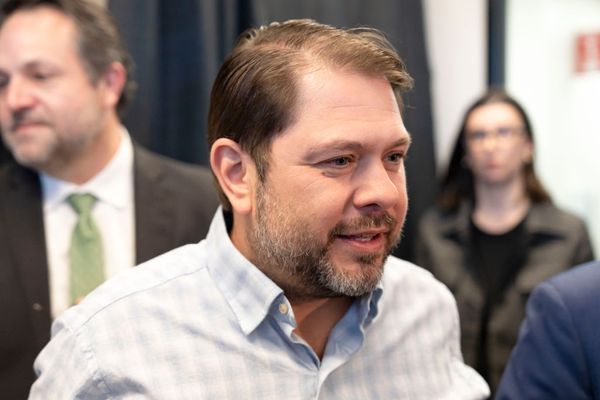
At Gagosian’s sleek Grosvenor Hill outpost, not far from Bond Street in London, is a punchy, rather masculine new exhibition that plays around with the detritus of the 20th century, both physical and philosophical, in ways guaranteed to make the visitor feel at once intoxicated and a touch queasy. Here are disembodied eyeballs and floating blond wigs. Here are distended sock dolls and plastic toy soldiers, greasily corrupt politicians and butcher’s shops that resemble murder scenes. Tube strike or not, on the day of my visit people were shopping as invincibly as ever in the streets outside the gallery. Passing them on my way in, I couldn’t help but think, furtively, of a dress I long to own. But no sooner was I inside the Gagosian’s vast spaces than such restlessness disappeared. The first thing I saw was a quiet reproach to my covetousness in the form of a watercooler that looked as if it had been turned suddenly to stone.

Watercooler (2011), which is made of graphite, is the work of Adam McEwen, one of more than 30 artists featured in the Gagosian’s show Haunted Realism, the overall effect of which is to expunge, even if only temporarily, your most libidinous desires. Guilt rising inside you – an inadvertent theme is the warming of the planet – the notion of consumption of any kind soon feels unnecessary and rather tasteless. Turn the first corner, for instance, and four images combine to make you feel even more than usually bad about late capitalism. First comes Hong Kong Shanghai Bank I (2020) by the German photographer Andreas Gursky: an image of an office block at night that resists all warmth in spite of the fact that every window is lit. Then there’s Richard Artschwager’s Industrial Complex (1967), a dishcloth-grey acrylic of urban nothingness that is painted on Celotex, a material used as insulation. Next to this hangs a print based on Gerhard Richter’s masterly blur of a painting September (2009), made in response to the attacks on the World Trade Center in 2001. Finally, there is Ed Ruscha’s Spied Upon Scene (2019), in which a rocky desert is encircled by black, as if we were looking at it through the sight of a gun.
These pieces have something in common besides their political subject matter: together, they embody a feeling of surveillance, a peeping Tom mood that continues, on and off, throughout the exhibition. Sometimes it arrives courtesy of old-fashioned voyeurism: Untitled (1961), a drawing of a nude by the now much disapproved-of bondage aficionado Hans Bellmer, hangs next to John Murphy’s photograph of a dead woman in a scarlet dress, Worse Days Are Coming (2022), the two in dialogue in highly uncomfortable ways. But at other moments it’s more explicit, the tables having been turned so it is the visitor who is observed. There are eyes all over the place, most notably in the form of Urs Fischer’s sculpture Dazzled (2016), a pair of knee-high, yellow-green orbs that have something of the fairground about them.

Haunted Realism, sometimes pulpy and sometimes eldritch, takes its title from “hauntology”, a word coined by Jacques Derrida to denote the way the past lingers inside the present. The term was then popularised by the late cultural critic Mark Fisher, a copy of whose 2009 book Capitalist Realism sits on a shelf at the Gagosian. (Fisher had it that we can no longer so much as imagine an economic system other than capitalism, for which reason his book’s appearance in the gallery tickled me: Gagosian, after all, is the art world’s leading luxury brand.) However, the exhibition’s main focus, we’re told, is on the way the aspirations of modernity have become “lost futures”, perceptible only as “ghostlike traces”; the artists on display tackle this by confronting the “accelerated flow of images” in contemporary culture and the proliferation of “non-places” we increasingly inhabit.
Personally, I think this show is best enjoyed unimpeded by theory. It’s a good introduction to some artists, mostly American, who are relatively unknown in the UK. I was drawn to Neil Jenney’s imaginary landscape of sand and ruins, Modern Africa #3 (2016-2020), struck by the way it brought to mind a frame from a comic book (think Charles Burns). Llyn Foulkes was a name new to me, and I enjoyed his mixed media portrait, Dick (2020), which features the wooden handle of (I think) a bradawl for President Nixon’s nose.


Mostly, though, it’s worth seeing for its unlikely and often brilliant juxtapositions. In one room, its curator, Mark Francis, has gathered together Untitled (Upstate), a group of prints (1995-99) documenting rural decline by the American photographer Richard Prince; Untitled (Black Bed) (1991), a sculpture of a mattress by Rachel Whiteread; and Trace (1993-94) by the figurative artist Jenny Saville, a typically unsparing oil of a naked back. They work so well together, these three, Saville’s expanse of waxen flesh now bringing to mind a mattress, and Whiteread’s sculpture seeming to have come straight out of one of Prince’s back yards. Seen like this, Whiteread’s abstraction shades into realism; Saville might have painted not a nude but a still life. As for Prince, an artist known mostly for his way with appropriation, he seems a more benign presence than usual – not so much a thief, you might say, as an influencer.
Haunted Realism is at the Gagosian Grosvenor Hill, London W1, until 26 August







